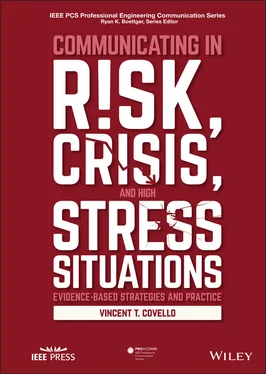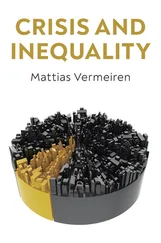85 Kasperson, R. E., and Stallen, P.J.M. eds. (1991). Communicating Risks to the Public: International Perspectives. Dordrecht: Kluwer.
86 Krimsky, S., and Plough, A. (1988). Environmental Hazards: Communicating Risks as a Social Process. Dover, MA: Auburn House.
87 Löftstedt, R. (2003). “Risk communication. pitfalls and promises.” European Review 11 (3):417–435.
88 Liess, W. (1996). “Three phases in the evolution of risk communication practice.” Annals of the American Academy of Political Social Science 545 (1):85–94.
89 Löfstedt, R. (2005). Risk Management in Post‐Trust Societies. New York: Palgrave Macmillan.
90 Löfstedt, R.E., and Bouder, F. (2014). “New transparency policies: Risk communication’s doom?” in Effective Risk Communication, eds J. Àrvai and L. Rivers III. London: Earthscan.
91 Lindenfeld, L., Smith, H., Norton, T., and Grecu, N. (2014). “Risk communication and sustainability science: lessons from the field.” Sustainability Science 9 (2):119–127.
92 Lundgren, R.E., and McMakin A.H. (2018). Risk Communication: A Handbook for Communicating Environmental, Safety, and Health Risks. Hoboken, NJ: Wiley‐IEEE Press.
93 McComas, K.A. (2006). “Defining moments in risk communication research: 1996–2005.” Journal of Health Communication 11(1):75–91.
94 McComas, K.A., Arvai, J., and Besley, J.C. (2009). “Linking public participation and decision making through risk communication,” in Handbook of Risk and Crisis Communication, eds. R. Heath and D. O’Hair. New York: Routledge.
95 Mileti, D., Nathe, S., Gori, P., Greene, M., and Lemersal, E. (2004). Public Hazards Communication and Education: The State of the Art. Boulder, Colo.: Natural Hazards Center.
96 Morgan, B., B. Fischoff, A. Bostrom, L. Lave, and C.J. Atman (1992). “Communicating risk to the public”. Environmental Science and Technology 26:2048–2056.
97 Morgan, M.G., Fischhoff, B., Bostrom, A., and Atman, C.J. (2002). Risk Communication: A Mental Models Approach. Cambridge, UK: Cambridge University Press.
98 National Research Council (1989). Improving Risk Communication. Washington, D.C.: National Academies Press.
99 National Research Council (1996). Understanding Risk: Informing Decisions in a Democratic Society. Washington, DC: National Academies Press.
100 National Research Council) (2008). Public Participation in Environmental Assessment and Decision Making. Washington, DC: The National Academies Press.
101 National Oceanic and Atmospheric Administration, US Department of Commerce. (2016). Risk Communication and Behavior. Best Practices and Research. Washington, DC: National Oceanic and Atmospheric Administration.
102 National Academy of Sciences/National Research Council (2008). “Public participation in environmental assessment and decision making,” in Panel on Public Participation in Environmental Assessment and Decision Making, eds. T. Dietz and P.C. Stern. Committee on the Human Dimensions of Global Change, Division of Behavioral and Social Sciences and Education. Washington, DC: The National Academies Press.
103 National Academy of Sciences (2014). The Science of Science Communication II: Summary of a Colloquium. Washington, DC: The National Academies Press.
104 National Academy of Sciences (2017). Communicating Science Effectively. Washington, D.C.: The National Academies Press.
105 Olsson, E. (2014). “Crisis communication in public organizations: dimensions of crisis communication revisited.” Journal of Contingencies and Crisis Management 22(2):113–125.
106 Olsson, E. (2015). “Transboundary crisis networks: the challenge of coordination in the face of global threats.” Risk Management 17(2):91–108.
107 Peters, E. (2012). “Beyond comprehension: The role of numeracy in judgments and decisions.” Current Directions in Psychological Science 21(1): 31–35.
108 Peters, R., McCallum, D., and Covello, V. T. (1997). “The determinants of trust and credibility in environmental risk communication: An empirical study.” Risk Analysis 17(1):43–54.
109 Pidgeon, N., Kasperson, R., and Slovic, P. (2003). The Social Amplification of Risk. Cambridge, UK: Cambridge University Press.
110 Renn, O. (1992). “Risk communication: towards a rational discourse with the public.” Journal of Hazardous Materials 29: 465–579.
111 Renn, O. (2008). Risk Governance: Coping with Uncertainty in a Complex World. London, UK: Earthscan.
112 Renn, O., and Levin, D. (1991). “Credibility and Trust in Risk Communication,” in Communicating Risks to the Public, eds. R. Kasperson and P. Stallen. Dordrecht, The Netherlands: Kluwer Academic Publishers.
113 Reynolds, B. (2014). Crisis and Emergency Risk Communication. Atlanta, GA: US Centers for Disease Control and Prevention.
114 Reynolds B., and Seeger, M.W. (2005). “Crisis and emergency risk communication as an integrative model.” Journal of Health Communication 10:43–55.
115 Ripley, A. (2009). The Unthinkable: Who Survives When Disaster Strikes ‐ And Why. New York: Harmony Books.
116 Rodrıguez, H., Dıaz, W., Santos, J., and Aguirre, B. (2007). “Communicating risk and uncertainty: science, technology, and disasters at the crossroads,” in Handbook of Disaster Research. New York: Springer.
117 Rogers, E.M. (1996). “The field of health communication today: An up‐to‐date report.” Journal of Health Communication 1 (1):15–23.
118 Sandman, P.M. (1989). “Hazard versus outrage in the public perception of risk,” in Effective Risk Communication: The Role and Responsibility of Government and Non‐Government Organizations, eds. V.T. Covello, D.B. McCallum, M.T. Pavlova. New York: Plenum Press.
119 Sandman, P.M (1993). Responding to Community Outrage: Strategies for Effective Risk Communication. Fairfax, Va.: AIHA Press,
120 Siegrist, M., Cvetkovich, G., and Roth, C. (2000). “Salient value similarity, social trust, and risk/benefit perception.” Risk Analysis 20(3):353–361.
121 Seeger, M.W. (2006). “Best practices in crisis communication: an expert panel process.” Journal of Applied Communication Research 34(3):232–44.
122 Sheppard, B., Janoske, M., and Liu, B. (2012). “Understanding Risk Communication Theory: A Guide for Emergency Managers and Communicators.” Report to Human Factors/Behavioral Sciences Division, Science and Technology Directorate, US Department of Homeland Security. College Park, MD: US Department of Homeland Security.
123 Slovic, P. (1987). “Perception of risk.” Science 236 (4799):280–285.
124 Slovic, P. (1993). “Perceived risk, trust, and democracy.” Risk Analysis 13(6):675–682.
125 Slovic, P. (1999). “Trust, emotion, and sex.” Risk Analysis 19(4):689–701.
126 Slovic, P. ed. (2000). The Perception of Risk. London, UK: Earthscan.
127 Slovic, P., ed. (2010). The Feeling of Risk: New Perspectives on Risk Perception. London: EarthScan.
128 Slovic, P. (2016). “Understanding perceived risk: 1978‐2015.” Environment: Science and Policy for Sustainable Development 58(1):25–29.
129 Slovic, P., M. Finucane, L., Peters, E., and MacGregor, D.G. (2004). “Risk as analysis and risk as feelings: Some thoughts about affect, reason, risk, and rationality.” Risk Analysis 24(2):311–322.
130 Slovic, P., Fischhoff, B., and Lichtenstein, S. (2001). Facts and fears: Understanding perceived risk. In The Perception of Risk, ed. Slovic, P. (pp. 137–153). London: Earthscan Publications Ltd.
131 Slovic, P., Krauss, N., and Covello, V. (1990). What should we know about making risk comparisons. Risk Analysis 10:389–392.
132 Stallen, P.J.M., and Tomas, A. (1988). “Public concerns about industrial hazards.” Risk Analysis 8(2):235–245.
133 Steelman, T. A., McCaffrey, S. (2013). “Best practices in risk and crisis communication: Implications for natural hazards management.” Natural Hazards 65(1):683–705.
Читать дальше












